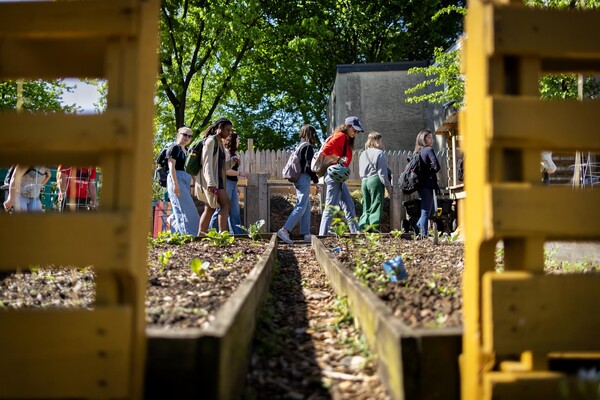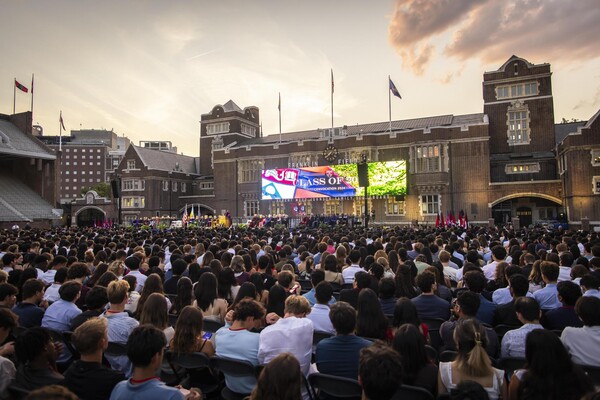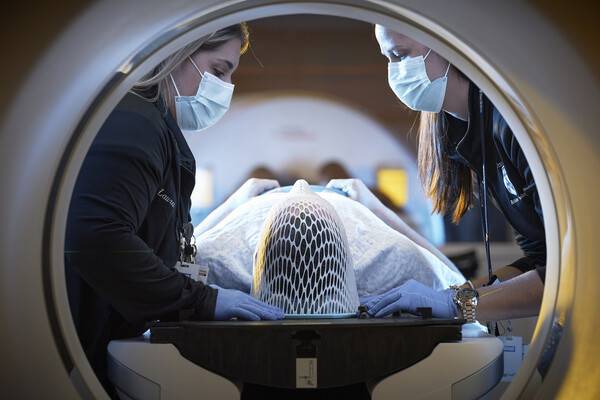Design goes underground
When Julia Moore Converse came to Penn 22 years ago, she already had curatorial stints at Harvard’s Fogg Museum and the National Gallery under her belt. Though less well known, Penn’s Architectural Archives—where she was offered the job of curator—was already a force to be reckoned with. The core of the collections, started by former Graduate School of Fine Arts Dean Holmes Perkins, was the Louis I. Kahn Collection, an extraordinary cache of drawings, sketches and plans by Penn’s best-known architecture professor and alum.
Before she accepted the job, Converse conferred with her cousin, architect Mark Ueland, who had studied with Kahn. “Mark told me I had no choice—that I simply could not say no to the opportunity to care for this wonderful collection.”
From small beginnings, the archives have grown to nearly 400 collections, with thousands of individual paper records, photographs and models. As well as preserving the past and serving as a resource for scholars, the archives also draws visitors to its Fisher Fine Arts Library digs with regular themed exhibits.
Since 1997, Converse has also served as assistant dean for external affairs in the School of Design. But though the day-to-day handling of the archives has passed to Collections Manager Bill Whitaker, Converse remains the director and keeps an office there. That way, she can stay close to the treasures that first drew her here.
Q. So first, how did you end up in the basement?
A. When I came in 1982, we had one little room up on the third floor. When we were working on the restoration of this building, I asked to take the bottom floor and everyone said, “Why do you want to be there in that basement?” There were artists’ studios and a back room that was referred to as the pit because it actually went down about six feet, and it wasn’t a place you’d want to be spending any time in. But we worked very closely with Venturi, Scott Brown, who were the architects for the restoration and through the wonderful design collaboration this is what we ended up with.
Q. What do you see as the purpose of the archives? Why keep all these bits of paper?
A. What we’re really interested in documenting is the process of design and why a designer would make changes, what changes he would make, how the early conceptual sketches compare to the finished building. So all those little pieces of yellow tracing paper are very important to us. We like to fully document these collections from their early stages, including the correspondence with the client, all the way through to the completion of the building.
Q. Are the archives used as part of the student curriculum?
A. Yes. This collection relates to our disciplines in the school. Architecture, landscape architecture, historic preservation, fine arts and city and regional planning—all of those are represented, and we use the collections as part of our program. Students come in and meet in the archives. We have our own seminar room, and they work with original materials.
Q. Are you one of Penn’s best-kept secrets?
A. When people walk around outside the building they have no idea what’s here. I don’t know how many thousands of people a day walk right by us. But we have people coming from around the world. We get busloads from Japan. And it’s funny because they’ll look at two things on the campus. They’ll look at the Richards Building and they’ll come here and then they’ll move on. We’re better known outside the University, I sometimes feel, than within.
Q. Are you still actively adding to the collections?
A. We’re constantly adding. One major new acquisition is a Kohn Pederson Fox model of their tower in Shanghai. That’s a very important acquisition for us. We have so many visitors from Asia, and they are thrilled to see that.
Q. I suppose many of the drawings are for projects that were never built.
A. Yes. We just acquired a model by [postmodern architect] Charles Moore. This was a project that was never built—a railroad bridge [across the Schuylkill] to 30th Street Station. It’s a kind of Ponte Vecchio. What’s wonderful is to have this record of what one designer thought of as an idea for Philadelphia. Those things are just as important to us as things that were built, particularly in Louis Kahn’s case, where so little of his work was actually built.
Q. Tell me about some of the more unusual items in the collection.
A. We collect all kinds of stuff, for example, the original drafting tables from over in Hayden Hall. We’ve got the drawings for these tables, too. There was a wonderful professor who’s passed away who just saw them throwing all this stuff out in the trash so he called me up and we went and got them.
Q. Fitting everything in here must be a challenge.
A. Our collections manager, Bill Whitaker, was trained as an architect. He and another work-study student have built a lot of our shelving and they continue to move and cram things around.
Q. So you know where everything is?
A. Well, the jury’s out on that one, but Bill has done an incredible job of space planning.
Q. Louis Kahn’s son, Nathaniel, must have found this a great resource when he was making his documentary, “My Architect.”
A. Yes, part of the movie was actually filmed in here. One of the wonderful things about working with Nathaniel is that we helped him a great deal making contacts and having access to our material but he also did hundreds of hours of interviews and outtakes that weren’t used in the film and all that will be coming to us. So we’re hoping to digitize it all and have a viewing station.
Q. Talking of digitizing, is the fact that many architects now use computers to design buildings affecting what you collect?
A. There’s a lot of study and discussion going on about how to archive digital material, so for now we’re holding back a bit. The Art Institute of Chicago has a big study group of people talking about this so we can get some real guidelines.
Q. Any favorite items in the collection?
A. One of the collections I really love shows early sketches of skyscrapers in New York City. They’re annotated with things like, “The light comes in very nicely.” The other is the Wilson Eyre collection because the quality of the drawings is just incredibly beautiful and he is an architect who’s really not well known but he was very active here. He designed the University Museum, the Mask and Wig Club, a couple of buildings out at the Morris Arboretum.
Q. What about a favorite building on campus?
A. There is no question. My favorite building is the one in which I work—the Fisher Fine Arts Library, a masterpiece by Frank Furness. The magnificent red color stops you in your tracks. Red brick, red sandstone, red terracotta roof tiles—it glows! In the archives we have blueprints of the construction drawings, and we also have the fabulous 1888 original presentation drawing, the one done by the architect to sell Penn on this design.
On the cover: Converse holds a model by Robert LeRicolais, a member of Penn’s architecture faculty from 1954 to1976.
Above: Converse and Collections Manager Bill Whitaker admire a model of the house Robert Venturi designed for his mother, Vanna.








